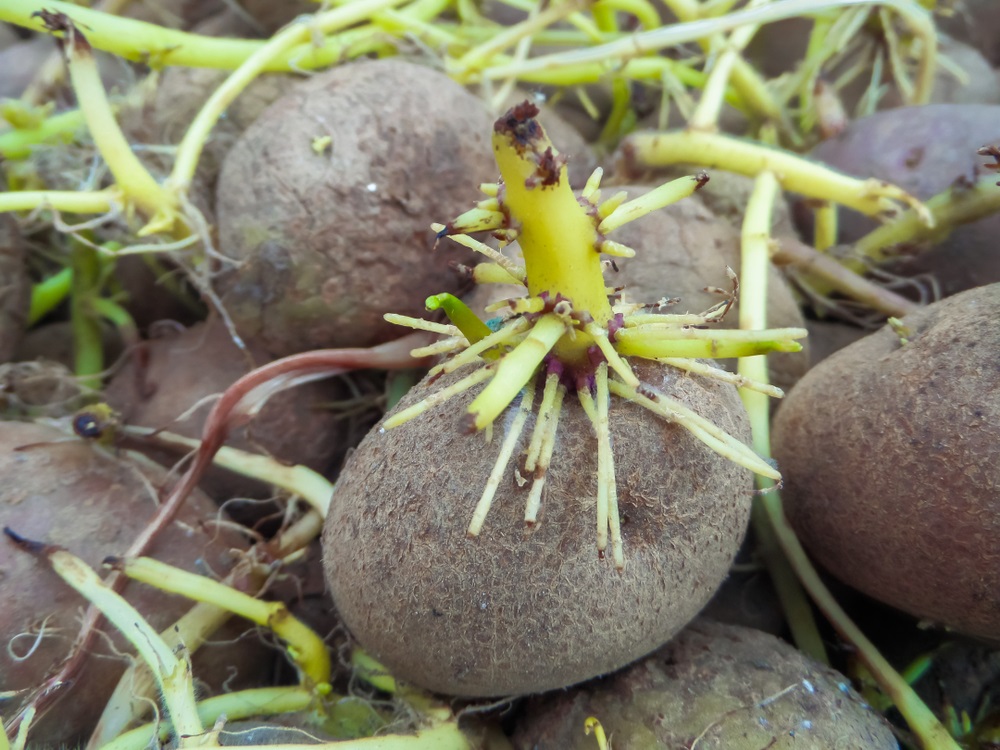While potatoes often come in large bags with several pieces, there is only so much you could eat in a short time. Hence, you might quite regularly be faced with the question of whether the potatoes in your pantry are still safe for consumption.
Like many other root crops, potatoes are still alive when picked. Hence, even in storage, potatoes continue to grow sprouts. This situation makes potatoes a somewhat perishable food source unsuitable for many forms of long term storage.
However, the factors like the sell-by date and the storage conditions can heavily influence the shelf life of any batch of potatoes.
Contents
How Long do Potatoes Last?
Unlike other perishable foods, potatoes typically come with a sell-by instead of a best-before date. Producers use this format because the shelf life of potatoes varies greatly depending on the storage conditions.
However, the sell-by date only acts as a recommendation on sale time rather than an estimate of spoilage. Hence, you can still use most batches of potatoes way past their sell-by date.
Potatoes can typically sit for up to 2 weeks at room temperature or in the pantry. However, under ideal storage conditions, potatoes can often last for more than a month without issues.
Cooked potatoes have a relatively shorter shelf life of 3 to 5 days, while frozen cooked potatoes typically retain their quality for up to 6 months.
Here is a guide with estimates of how long potatoes can last past the sell-by date:
| Pantry | Fridge | Freezer | |
| Raw Potatoes | 2-3 weeks | 1-2 months | – |
| Cooked Potatoes | – | 3-5 days | 6-8 months |
| Instant Dry Potato | 1 year | 4-5 days | – |
How to Tell if Potatoes are Rotten or Spoiled
Telltale signs of potato spoilage are discoloration and abnormal growth across the skin of the tuber. Furthermore, as potatoes begin to degrade, they will also get soft, wrinkled, and eventually start withering.
Green spots and sprouts can be signs of aging or excessive exposure to heat or sunlight. However, they do not render the potatoes unsafe as you can remove the shoots and green spots and safely eat the rest of the tuber.
Moisture is another cardinal enemy of the potato. Potatoes stored in humid conditions can begin to develop mold growths. Washing potatoes before storage also increases the risk of future mold growth.
Spoiled or moldy potatoes can pose significant health risks and should be discarded immediately.
How to Store Your Potatoes to Keep them Fresh
The most critical factor in storing potatoes for maximum shelf life is the temperature. The ideal temperature for preserving potatoes is in the range of 45°F to 50°F.
However, this temperature requirement presents a problem: it is significantly higher than room temperature in your pantry yet not cold enough to match standard fridge temperature. Hence, you have to create a unique temperature scenario for optimal potato storage.
One way to achieve this is to store your batch in an unheated basement or cellar that gets cold enough. Alternatively, if you have a fridge that you can afford to keep at a relatively higher temperature than average, that is a perfect spot for potatoes.
Storing potatoes at extremely high temperatures will hasten the rate at which they shrink and sprout. Potatoes are constituted of 80% water; hence, they are susceptible to heat and will rapidly shrink, losing water weight in extreme conditions.
Conversely, if you keep potatoes in temperatures lower than the 45°F to 50°F range, the potato starch rapidly converts into sugar. While this sugar production does give the potatoes a sweet taste, it also causes them to darken faster during cooking.
Furthermore, potatoes are best stored in a cool and dark area away from direct sunlight in average humidity conditions.
Washing Potatoes
Washing potatoes significantly reduces their shelf life and increase the chances of spoilage. The dirt around a potato forms a natural shield that helps it retain its original composition by slowing down degradation.
However, once you wash this layer off, the rate at which potato spoils quickens. Hence, you should only wash potatoes when you are ready to prepare them.
Dealing with Sprouts
Sprouting is another familiar foe of your home batch of potatoes. Potato sprouts use up nutrients in your tubers by converting the starch into sugar.
Furthermore, sprouts often go hand in hand with potatoes turning green. Greening and sprouting of potatoes produce toxic chemicals called glycoalkaloids. In a significant concentration, these substances can cause stomach upsets and nausea.
The good news, however, is that even sprouted potatoes are often safe to eat. The only condition, however, is that they are still firm to the touch and have not undergone much discoloration. You can remove the sprouts from a firm potato and continue cooking your recipe.
Cut Potatoes
Once you cut raw potatoes, they degrade quickly from oxidation and change into a brownish color. You can reduce this damage by inserting them in a pan of salted or freezing water immediately after each cut.
Cooked Potatoes
Cooked potatoes degrade the fastest and are usually good for only a few hours at room temperature. However, they can often last for a few days or even months if properly refrigerated.
Freezing Potatoes
Raw potatoes do not freeze well as the starch will degrade rapidly. However, you can freeze cooked or otherwise prepared potatoes provided you store them in a tightly sealed container to keep out moisture and any potential contaminants.
